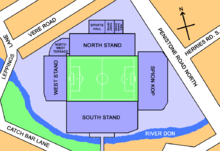Hillsborough Stadium
| Hillsborough Stadium | |
|---|---|
| Hillsborough | |

|
|

|
|
| Aerial view of the stadium | |
| Earlier names | |
|
Owlerton Stadium (1899-1914) |
|
| Data | |
| place |
|
| Coordinates | 53 ° 24 '41.1 " N , 1 ° 30' 2.4" W |
| owner | Sheffield Wednesday |
| opening | September 2, 1899 |
| First game | 2 September 1899 Sheffield Wednesday 5-1 Chesterfield FC |
| Renovations | 1914, 1960-1961, 1994 |
| surface | Natural grass |
| capacity | 39,812 seats |
| playing area | 106 × 65 m |
| Societies) | |
| Events | |
|
|
The Hillsborough Stadium (also briefly Hillsborough called) is a football stadium in the English Sheffield . It is the home ground of the Sheffield Wednesday football club . It has hosted the club's games since the first turf was laid in 1899. Today the venue holds 39,812 spectators on its four grandstands, most of which are covered. Hillsborough Stadium is named after the neighborhood that surrounds it. It gained notoriety around the world as the scene of the viewer disaster of 1989 .
history
The first place on the site of the current stadium was built in 1899 in a sparsely populated area in northwest Sheffield, then called Owlerton. The course was called Owlerton Stadium until 1914 and then renamed to correspond with a number of structural improvements in the area. The thriving part of town that grew up around the stadium was called Hillsborough , after which the stadium was named.
In 1966 the stadium was selected as a venue for the soccer World Cup and was used for three first-round matches, in which the teams from the Federal Republic of Germany , Argentina , Switzerland and Spain took part. The quarter-final match between the Federal Republic of Germany and Uruguay (result: 4-0) was also played there.
In 1989, the stadium was the site of the Hillsborough disaster , when 96 Liverpool FC fans were pressed to death during an FA Cup semi-final match . This disaster led to some changes to the stadium's stands. Little by little, all standing stands were equipped with seats and the fences around the playing field were replaced by low safety barriers so that spectators can move onto the playing field in an emergency.
Visitor record and average attendance
The highest number of spectators was achieved on February 17, 1934 as part of the game of the 5th round in the FA Cup 1933/34 against Manchester City with 72,841 visitors. A record number of visitors was set as a modern seating stadium on February 2, 2000. The 1999/2000 Premier League match against Manchester United saw 39,640 spectators.
- 2014/15 : 21,993 ( Football League Championship )
- 2015/16 : 22,641 (Football League Championship)
- 2016/17 : 27.129 (EFL Championship)
Grandstands
North Stand
- Built: 1961
- Capacity: 9,255 seats
The grandstand extends across the north side of the lawn and is one of the earliest examples of cantilever construction and one of the first grandstands in England to span the full width of the pitch. The first cantilevered grandstand was built on the field of the Scunthorpe United Club , Old Show Ground. Thanks to this grandstand, Hillsborough Stadium is the only football stadium that is mentioned in the book Buildings Of England by Nikolaus Pevsner .
Presto West booth
- Built: 1966
- Capacity: 6,559 seats
Located on the the Leppings Lane pointing end of the square this grandstand can accommodate the supporters of visiting teams at home games of Sheffield Wednesday. It was originally built for the Football World Cup in 1966 and before the Hillsborough disaster in 1989 contained a standing stand, which was then converted into a pure seating stand.
South Stand
- Built: 1914
- Capacity: 11,354 seats
Construction on this oldest grandstand in the square began in 1913, based on designs by designer Archibald Leitch , whose salary for the plans was £ 17,000 . Today's grandstand has undergone several improvements. The current example of this is the construction of press booths, two conference rooms, a bar and a restaurant as well as an additional upper tier of seats for the 1996 European Football Championship .
The South Stand is the most recognizable grandstand within the stadium and still contains the old view with a clock from 1913. It houses the main reception area, press and food areas, the family area and seven modern refreshment kiosks.
Spy Kop
- Built: 1914
- Capacity: 11,210 seats
The Spion Kop was upon a hill, the scene of a battle in the Boer War , was named and built on a natural hill at the east end of the square. At Sheffield Wednesday home games, this is where the team's most vocal supporters are.
The grandstand was the last in the stadium to be converted into a purely seated grandstand, primarily in order to comply with the new guidelines of the Premier League . The last renovation took place in 1993.
Panorama picture
Web links
- AZ of Hillsborough ( Memento of February 2, 2016 in the Internet Archive ) (English)
- footballgroundguide.com: Stadium description (English)
- groundhopping.de: Visitor report from 2003
- stadionwelt.de: picture gallery
Individual evidence
- ↑ stadiumdb.com: stadium capacity (English)
- ↑ footballgroundguide.com: Record attendance and average attendance (English)

